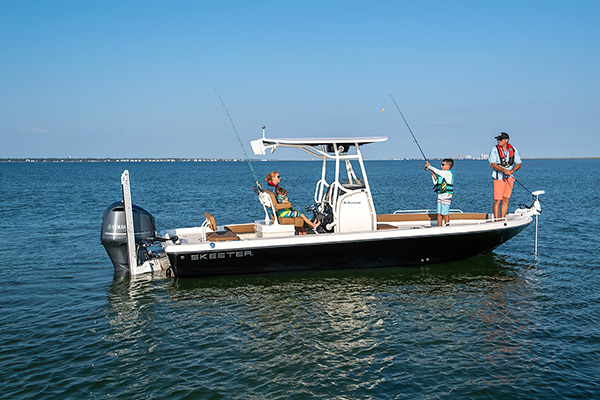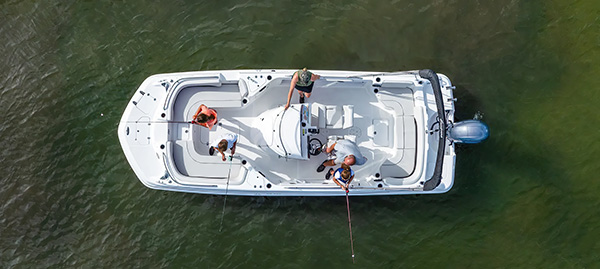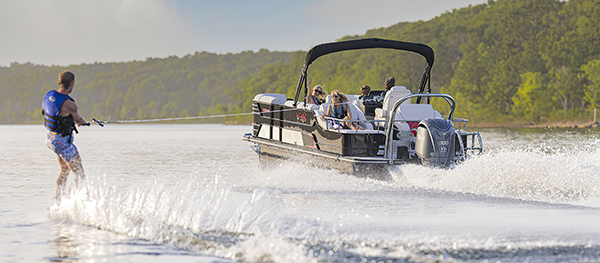Finding a boat that matches your lifestyle might seem daunting, but looking at specific features and characteristics can often steer you in the right direction. A knowledgeable boat dealer will ask many questions that will help narrow the field. The same questions can help prospective buyers in their hunt to find the perfect boat…for them.
How much does a boat cost?
The first step to buying the ideal boat is finding one you can afford. When trying to work out a boating budget, the cost of the boat is only one of the considerations. Should you buy a new boat or a used one? Remember that older boats usually require more maintenance, so a smart buyer will factor this added cost into their bottom-line decision. Other expenses include storage, insurance, finance charges, and accessories. And don’t forget about gas!

How big of a boat do you need?
Many factors go into deciding how big of a boat to buy, and while cost is one of the most significant factors, bigger isn’t always better. Its suitability for a buyer’s usage should be the overriding reason for the decision. If you plan to head offshore, a 25-footer boat is probably the minimum length to choose. Sometimes, the type of boat is more important than just size. If the goal is to take the family or friends out for a cruise or to engage in recreational watersports, a boat at least 22 feet long with an open bow like a dual-console, bowrider, or deck boat is an excellent choice because of the added seating. It’s hard to beat a pontoon for its expansive seating ability and versatility in inland waterways. A pontoon with at least a 150-horsepower outboard and triple tubes is ideal for entertaining, on-plane cruising and pulling skiers. Many have fishing options that will satisfy the avid angler in the family without compromising its entertainability. An average 24-foot triple-tube pontoon boat has a passenger capacity of about a dozen. Remember that larger boats might require more towing vehicle capability, and any boat with a beam larger than 8 feet 6 inches will mandate those towing them to take added steps such as getting oversized permits and displaying flags and signage.
How much range does a boat need?
If you have a particular destination in mind, knowing the size of the fuel tank and the estimated mileage will be valuable information. When reading boat reviews and performance tests, consider they are often done under ideal conditions, and if a boat is loaded with people, gear, and fuel, its economy will reflect the extra weight. Use the rule of thirds as a general guideline: one-third to get to a destination, one-third to bet back, and a third for a reserve.
Should you buy a boat with a cabin?
If a boat is used as a floating hotel, the quality of its overnight accommodations should be high on the priority list and include a galley and head compartment. But space allocated for cabins comes at the expense of open areas and fishing room. If a cabin’s primary uses are as a kid’s fort, a temporary refuge from the elements, a location for a head, or a storage place, it should receive less emphasis. Remember that a boat’s console can serve many of the same purposes without wasting as much space. Larger center console fishing boats often have air-conditioned berths.

What features do the best fishing boats have?
If fishing will be the central activity, there are several must-have features. A well-equipped boat will have lots of rod holders set into the gunwales, along the transom, and on the back of a T-top and leaning post. Don’t forget rod storage in places like under gunwales and vertical holders on either side of a center console boat. Livewells with at least 20 gallons of capacity and the ability to recirculate the water are a huge plus. Offshore boats should have pressurized livewells to keep water from sloshing around and sea chests to prevent air from entering the system when running.
Serious fishing boats will have at least two large-screen electronics for navigation and marking fish on sonar. The latest trend is to use trolling motors as virtual anchors, cutting the need to deploy real ones. Even boats as long as 40 feet use them to give skippers a quick and quiet way to hold a boat’s position. Boats equipped with Yamaha Helm Master® EX have unique advantages for boat control when drifting or holding a precise position.
A boat designed to fish offshore is usually larger, has a generous amount of freeboard, and features a hull that often has 20 degrees of deadrise or more to help it slice through rough water. Inshore boats are smaller and often have a lower freeboard, making casting lures at shorelines easier. They typically have less deadrise, which enables them to get on plane quickly, run in shallower water, and provide more side-to-side stability when at rest. A newer class of boats called hybrids bridges the gap between offshore and inshore boats and is an excellent choice for anglers who fish in a wide variety of waters.
What features make a boat suitable for towing watersports?
For watersports, look for boats that make it easy for skiers to get in and out of the water. They should also have plenty of storage that’s large enough for skis and towable tubes. If your boating activities include fishing, consider a model with a ski pylon or a ski tow bar instead of a wakeboard tower, as they hinder casting or fighting a fish. Seating layouts that contain at least one rear-facing seat are ideal for spotters.
.jpg)
How much power does a boat need?
Boat builders sometimes offer a model at an attractive sale price, but it might come with an engine that’s not powerful enough to meet an owner’s needs. Also, having the lowest horsepower engine for a particular model will reduce resale value. Choosing a power option that allows a boat to perform well with the largest expected load is a good strategy. Even if going fast isn’t one of the goals, having a snappy throttle response helps get a boat on plane quickly and is needed for situations like cruising through a rough inlet where the driver needs to maintain a boat speed that’s barely on-plane. Some boat builders give buyers the choice to add exotic racing engines that are proportionally more expensive than the added horsepower. Generally, when shopping, look for a power choice that gives you the most horsepower for the money. When shopping, having a checklist of needed features and comparing them side-by-side is an effective way to decide which model is the perfect boat for your family.
Back to Blue Life
How much does a boat cost?
The first step to buying the ideal boat is finding one you can afford. When trying to work out a boating budget, the cost of the boat is only one of the considerations. Should you buy a new boat or a used one? Remember that older boats usually require more maintenance, so a smart buyer will factor this added cost into their bottom-line decision. Other expenses include storage, insurance, finance charges, and accessories. And don’t forget about gas!

How big of a boat do you need?
Many factors go into deciding how big of a boat to buy, and while cost is one of the most significant factors, bigger isn’t always better. Its suitability for a buyer’s usage should be the overriding reason for the decision. If you plan to head offshore, a 25-footer boat is probably the minimum length to choose. Sometimes, the type of boat is more important than just size. If the goal is to take the family or friends out for a cruise or to engage in recreational watersports, a boat at least 22 feet long with an open bow like a dual-console, bowrider, or deck boat is an excellent choice because of the added seating. It’s hard to beat a pontoon for its expansive seating ability and versatility in inland waterways. A pontoon with at least a 150-horsepower outboard and triple tubes is ideal for entertaining, on-plane cruising and pulling skiers. Many have fishing options that will satisfy the avid angler in the family without compromising its entertainability. An average 24-foot triple-tube pontoon boat has a passenger capacity of about a dozen. Remember that larger boats might require more towing vehicle capability, and any boat with a beam larger than 8 feet 6 inches will mandate those towing them to take added steps such as getting oversized permits and displaying flags and signage.
How much range does a boat need?
If you have a particular destination in mind, knowing the size of the fuel tank and the estimated mileage will be valuable information. When reading boat reviews and performance tests, consider they are often done under ideal conditions, and if a boat is loaded with people, gear, and fuel, its economy will reflect the extra weight. Use the rule of thirds as a general guideline: one-third to get to a destination, one-third to bet back, and a third for a reserve.
Should you buy a boat with a cabin?
If a boat is used as a floating hotel, the quality of its overnight accommodations should be high on the priority list and include a galley and head compartment. But space allocated for cabins comes at the expense of open areas and fishing room. If a cabin’s primary uses are as a kid’s fort, a temporary refuge from the elements, a location for a head, or a storage place, it should receive less emphasis. Remember that a boat’s console can serve many of the same purposes without wasting as much space. Larger center console fishing boats often have air-conditioned berths.

What features do the best fishing boats have?
If fishing will be the central activity, there are several must-have features. A well-equipped boat will have lots of rod holders set into the gunwales, along the transom, and on the back of a T-top and leaning post. Don’t forget rod storage in places like under gunwales and vertical holders on either side of a center console boat. Livewells with at least 20 gallons of capacity and the ability to recirculate the water are a huge plus. Offshore boats should have pressurized livewells to keep water from sloshing around and sea chests to prevent air from entering the system when running.
Serious fishing boats will have at least two large-screen electronics for navigation and marking fish on sonar. The latest trend is to use trolling motors as virtual anchors, cutting the need to deploy real ones. Even boats as long as 40 feet use them to give skippers a quick and quiet way to hold a boat’s position. Boats equipped with Yamaha Helm Master® EX have unique advantages for boat control when drifting or holding a precise position.
A boat designed to fish offshore is usually larger, has a generous amount of freeboard, and features a hull that often has 20 degrees of deadrise or more to help it slice through rough water. Inshore boats are smaller and often have a lower freeboard, making casting lures at shorelines easier. They typically have less deadrise, which enables them to get on plane quickly, run in shallower water, and provide more side-to-side stability when at rest. A newer class of boats called hybrids bridges the gap between offshore and inshore boats and is an excellent choice for anglers who fish in a wide variety of waters.
What features make a boat suitable for towing watersports?
For watersports, look for boats that make it easy for skiers to get in and out of the water. They should also have plenty of storage that’s large enough for skis and towable tubes. If your boating activities include fishing, consider a model with a ski pylon or a ski tow bar instead of a wakeboard tower, as they hinder casting or fighting a fish. Seating layouts that contain at least one rear-facing seat are ideal for spotters.
.jpg)
How much power does a boat need?
Boat builders sometimes offer a model at an attractive sale price, but it might come with an engine that’s not powerful enough to meet an owner’s needs. Also, having the lowest horsepower engine for a particular model will reduce resale value. Choosing a power option that allows a boat to perform well with the largest expected load is a good strategy. Even if going fast isn’t one of the goals, having a snappy throttle response helps get a boat on plane quickly and is needed for situations like cruising through a rough inlet where the driver needs to maintain a boat speed that’s barely on-plane. Some boat builders give buyers the choice to add exotic racing engines that are proportionally more expensive than the added horsepower. Generally, when shopping, look for a power choice that gives you the most horsepower for the money. When shopping, having a checklist of needed features and comparing them side-by-side is an effective way to decide which model is the perfect boat for your family.
Back to Blue Life
